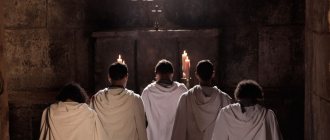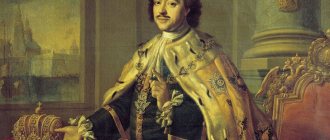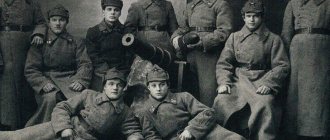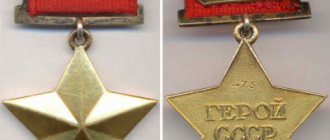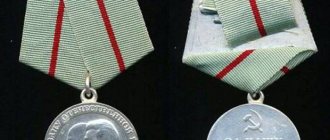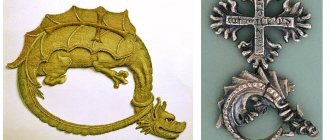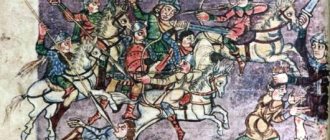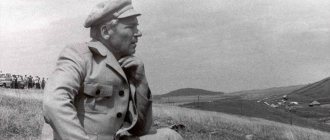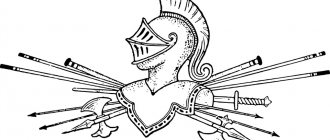The Templars (from the French “templiers” or “temple” - “templars”, “church”, “temple”) were also called the Mendicant Knights of Christ and the Temple of Solomon. They were among the first to form military-religious orders. Thus, the order was founded in 1119 by a small group of knights, led by Hugh de Payns.
This occurred in the wake of the First Crusade, to maintain the new Kingdom of Jerusalem, surrounded by its defeated Muslim neighbors, and to provide security for the many European pilgrims heading to Jerusalem following its conquest. However, it is worth making a distinction between the actual creation of the Templar Order, the beginning of its life and official recognition from the Pope, when it became an independent monastic brotherhood.
A brief history of the spiritual-knightly order of the Templars
When the First Crusade (1096-1099), which was supposed to liberate the Holy Land from Muslim supremacy, ended, something like a Christian state was created in the Eastern Mediterranean, which was called the Kingdom of Jerusalem. Small state formations also appeared, along with Tripoli, Antioch, the Kingdom of Cilicia, the County of Edessa, as well as the Assassins.
These Christian lands were given a name - the Latin East, and the main capital city began to be called Jerusalem.
It was completely natural that the European population began to systematically carry out pilgrimages to holy places. However, robbers, robbers, and dashing people roamed all the roads, unceremoniously and unscrupulously engaged in robbing pilgrims, and from time to time, killing them. Thus, the road to the east to visit holy places seemed to be a deadly dangerous undertaking.
Ave Maria, Deus Vult
Despite the theory common in popular anti-science books, the Templars never had any hidden agenda. After a successful campaign in the Middle East at the beginning of the millennium, Christians managed to occupy a number of cities that are now located in modern Syria, Israel, and so on.
These places are not simple, but sacredly important for every true believer. So they decided to create several quasi-states, sanctions for which were issued personally by the Pope. The Principality of Antioch and the Kingdom of Jerusalem attracted not only tourists, but also dangerous religious opponents - the Saracens.
Of course, allowing bandits to roam freely around the world's main pilgrimage routes is not the smartest idea. So several knights decided to take an oath and unite with a common charter and their own laws. The public demand for someone like the Templars can be clearly seen at the beginning of the 12th century, so their appearance seems as logical as possible. Even without theories of alien intervention or an incredibly cunning plan.
By the way, they did not say the phrase Deus Vult. This was the cry of the knights from the First Crusade.
Founding of the Templar Order
All this chaos continued for almost twenty years, until one day in 1118 a small detachment with noble knights passed along the dusty Palestinian roads. It was he who began to protect the pilgrims from robbers and all sorts of rabble. They went about their business with all their hearts, not out of fear, but out of conscience. The knights treated robbers mercilessly, and for believers they paved a safe road through holy places.
This small knightly team was led by a man named Hugh de Payns. He came from an ancient French noble dynasty, which at one time served its state faithfully and truly. At the age of fifteen, Hugo was knighted. From that moment on, the young man joined the caste of professional warriors - the French knights. The young man was lucky enough to become a participant in the crusade and liberation of Jerusalem.
A brief history of the organization of the activities of the Templars
The word “poor” deliberately emphasizes the ascetic lifestyle of the members of the brotherhood, who put service to Christ above earthly goods received during life. This is echoed by the legend surrounding the history of the creation of the order, according to which the founders of the organization were 9 poor knights. The symbol of brotherhood has become an emblem depicting two riders riding on one horse, which once again emphasizes the image of the poor champions of Christ.
Some sources claim that the reason for the appearance of such an emblem is more likely to have economic motives. Due to their difficult financial situation, the Templars could not afford to have their own horse. This fact is actively disputed today because knighthood requires the obligatory presence of one’s own horse. Probably the combination with two riders on one horse is a successful advertising trick that the Templars resorted to, deciding to create an aura of asceticism and disdain for material values around themselves.
During the period of persecution of members of the brotherhood, the emblem of the Templar Order was used by opponents of the Templars as evidence of the deadly sin - sodomy, which is the connecting link between members of the brotherhood.
The number of members of the order at the time of its founding was small. The founders included nine French knights who were participants in the first crusade. Their number, along with Hugh de Payns, de Saint-Omer and André de Montbard, included other comrades-in-arms of Godfrey of Bouillon.
As befits any serious organization, its activities were regulated by the charter of the Templar Order, which was adopted in 1128. The text directly states that this document was adopted 9 years after the creation of the brotherhood of knights, i.e. All the previous 9 years the order existed in a semi-legal position. The leading role in the formation of the brotherhood was played by Saint Bernard, the Abbot of Clairvaux, to whom the knights turned for help in organizing the new order. He became interested in the endeavors of the knights who took vows of monasticism. The abbot developed a charter for the brotherhood of warrior monks and took upon himself the troubles before the Pope for the legalization of the new institution.
Among the merits of the Abbot of Clairvaux is the commitment of the templars to wear white capes over their armor with a red eight-pointed cross in the heart area. The white vestments strikingly distinguished the Templars from the knights - monks of the Order of the Hospitallers in black cassocks. The abbot kept this promise and in 1128, at a council in Troyes, Pope Honorius II announced the formation of the Order of the Knights of Christ and the Temple of Jerusalem. The new monastic and military order was headed by Hugh de Payns, who received the status of Grand Master.
Emphasis should be placed on the existing hierarchy within the Order. The head of the brotherhood (Order) is the Grand Master, followed by the following positions and titles:
- commander of the Order - he is also the head of a large military unit;
- priors - the level of governor or commandant of a certain region (territory);
- officers are mid-level military leaders;
- sergeants are ordinary members of the order.
Promotion up the career ladder was carried out taking into account military and other merits to the order. The knights formed the basis of the military units and administration of the order. The brotherhood was served by servants and grooms, who performed the functions of squires during campaigns. Within less than 200 years, 23 Grand Masters were elected.
If we talk about the content of the order’s charter, then it more than accurately conveyed the entire organization of the brotherhood from the inside. The usual monastic vows of obedience were based on a commitment to worldly poverty and chastity. It was these two aspects that became the main motto of the templar brotherhood. The charter gave instructions regarding abstinence from earthly goods and excesses. Along with compulsory attendance at Mass, the brothers were required to engage in regular exercise and military training. Meat was allowed to be consumed three times a week, while maintaining purity of spirit and thoughts.
Along with the main provisions set out in the charter of the order, there was an oath that all members of the fraternity took. The main provisions of the knight's oath were as follows:
- help the poor;
- at the cost of one’s own life, to help brothers in the order who are in trouble;
- do not respond to insults and provocations of the knight of the Christian faith;
- be able to take on three opponents at once.
Violation of this oath was severely punished, including the use of corporal punishment. It should be noted that it was the Knights of the Temple who were considered the most consistent in their beliefs. Thanks to the contribution of Abbot Bernard, the Catholic Church received a powerful military-political instrument into its hands. We can say that Bernard managed to achieve the impossible. Using the militant ardor and enthusiasm of the knights, Bernard was able to channel these qualities into the service of a holy cause. From now on, knights not only fought for honor, but were forced to go into battle out of religious convictions.
Versions of the origin of the Templar Order
Hugh de Payns did not return home because he decided to stay on the land of Palestine. Having found unmercenaries like himself, he teamed up with them, and together they stood up to protect the wanderers. According to one version, these were nine knights known as nova militia christi, who united in France, where they vowed to protect pilgrims. After this they returned to Palestine.
Many of them were so poor that they did not have enough money even to purchase a sufficient number of horses. Often two riders could sit on one horse. However, this all lasted for about a year, until the court of King Baldwin II of Jerusalem paid attention to the fighting team protecting travelers for free.
The king himself treated the brave knights with favor, and under his patronage they decided to unite into an order. At the same time, they took the oath of allegiance not to the monarch, but to the Jerusalem Church of the Holy Sepulcher. We can say that this is exactly how the knights of the temple or templars appeared. In French it was pronounced - Templars. This is exactly how the Order of the Templars appeared in 1119, headed by Hugo de Payns.
Who are the Templars? Where does this movement come from?
The history of the spiritual-knightly order of the Knights of the Temple is closely connected with Christianity, which experienced difficult times at the turn of the first and second millennia. The Christian world in the early Middle Ages was in an extremely fragmented state. After the collapse of Charlemagne's Empire, civil strife reigned in Europe. On the fragments of the once powerful Frankish empire, new kingdoms, duchies and principalities arose, which tried to take leading positions in European and world politics. At this moment, the influence of the church, which previously acted as the cementing material of any monarchy, significantly weakened.
The Catholic Church urgently needed a new idea that would not only restore the influence of the church, but also become a unifying factor for the entire Christian world. Such an initiative was soon found. In 1096, at a church council in Clermont, Pope Urban II proclaimed the idea of liberating Jerusalem and the entire Holy Land from Muslim rule. From this moment in the history of Europe, a new stage of development began, associated with the beginning of Christian expansion.
It was during this period that the Templars appeared on the political arena on a wave of religious enthusiasm. At the same time, other knightly orders - military-political organizations of a religious nature - appeared under the banner of the struggle for the Christian faith. Each of the newly formed orders pursued its own goals, but it was the Templars who secured the glory of the true defenders of the Holy Sepulcher.
The orders that were created were both monastic and knightly, i.e. had religious overtones. However, unlike the Order of St. John (Hospitaliers), which was directly subordinate to the Pope, the new religious-military organization was independent. The knights, united in a religious-knightly congregation, did not obey either the Pope or fall under the influence of secular authorities. The creation of the Templar Order coincides in time with the current events taking place in the First Crusade, which turned out to be the only such event that followed. In the Middle East, the crusaders managed to defeat individual Seljuk detachments, briefly weakening Muslim rule.
Historians attribute the founding of the Knights Templar to various historical figures. According to one version, in 1099 Godfrey of Bouillon, who proclaimed himself king of Jerusalem, initiated the creation of a new military-religious organization.
According to another version, the initiative to create a knightly order belongs to the associates of the King of Jerusalem Baldwin II - the French knights. In 1118, nine knights, led by Hugh de Payns and Saint Omer, offered their services to the King of Jerusalem to protect the shrines. The first subsequently became master of the order. By the way, these numbers appear in the Charter of the order as the date of foundation of the brotherhood.
First of all, the emphasis was placed on the military component of the new organization, since it was necessary to create some kind of royal guard, a powerful and well-trained paramilitary unit. The origin of the new military organization, despite the propaganda of high ideals, is explained by banal needs. Christian shrines in the land of Palestine and thousands of pilgrims needed constant protection not only from Muslims, but also from attacks by robbers and robbers who appeared on these lands with the arrival of Europeans. The new order became a real military force capable of defending the European conquests in the Middle East.
The name that the order received also corresponds to the stated goals. Initially, the knights united into a brotherhood in the name of a high goal - the protection of Christian shrines. King Baldwin II, having accepted the offer of the poor knights, determined the location of the new brotherhood to be the place where Solomon's Temple was supposedly once located. The new spiritual brothers set up their headquarters and barracks on the site of the former Muslim Al-Aqsa mosque. Due to this location, the population of the city quickly dubbed the new brothers templars. As a result, a Europeanized name of the order appeared. The temple is called "temple" in French. Accordingly, the subsequent name of the participants of the new brotherhood follows from this - Knights of the Temple, Templars or Templars.
Officially, the order bore a number of other names, one way or another related to the main mission - the protection of the Holy Sepulcher and other shrines. At different times and in different places, the templars were called the poor knights of Christ or the poor warriors of Christ and the Temple of Solomon. Less frequently heard was the name Order of the Poor Knights of the Temple of Jerusalem.
Activities of the Templar Order
At first, almost no one knew whether the Order of the Templars existed, but over time its fame began to increase. The noble knights were allowed to go to Europe and recruit people of noble birth into the order. European kings liked the idea. All of them respected the Knights Templar, who, guided only by the call of their hearts, stood up for the pilgrims going to the Holy Land.
A whole series of favors suddenly rained down on the Templars. All this was expressed in the granting of lands and castles to them. Thus, the poor knights became rich in an instant.
The French nobility was particularly generous. The fact is that the Grand Master of the Knights Templar treated their compatriots. Subsequently, they began to formally talk about the order as French. And this despite the fact that in its ranks there were people of very different origins.
The rise and power of the order. Secrets and riddles of the templars
With the continuation of the Crusades, the authority of the knights-monks of the Order of the Temple only grew stronger and intensified. Warriors-templars in white cassocks with a purple cross on the chest took part in all major battles and battles of that time, often marching to the most dangerous areas. Many of them became legendary figures, going down in history as consistent and brave warriors of Christ. With the end of the Crusades, which ended with the displacement of Christians from Palestine, the activity of the order did not cease. After the loss of the last Christian strongholds in the Middle East in 1291, the Templars settled briefly in Cyprus, where they stayed for less than 20 years.
It was no longer a religious-military brotherhood of poor knights. Over almost a hundred and fifty years of its existence, the order transformed into a huge corporation, where, along with military crafts, other services were provided, including financial and transport services. This led to the fact that the religious-military brotherhood was able to turn into such a powerful and powerful organization. Many historians and theologians associate the power of the Templars with the discoveries that were made by the monks during their stay in the Holy Land. According to some historians, possession of the Ark of the Covenant allowed the Templars to find a way to countless treasures. The sudden appearance at the disposal of the Order of enormous financial resources is the main secret of the Templar Order.
The won and deserved authority that the brotherhood acquired is the main reason that over time the Templars became the most popular monastic order in medieval Europe. This became possible thanks to strict adherence to the hierarchy within the order and the organization of the brotherhood itself. High military skill and valor only enhanced the achieved effect. Almost all French nobility and aristocracy were members of the Order. Many of the secular gentlemen preferred the attire of a simple monk and the ascetic life of a warrior to a rich and prosperous life.
France was not the only European country where the Templars settled. Throughout Europe, the Templars built their castles and fortresses. The influence of the Templars in other countries was great, especially in Spain and Portugal. The Order had political weight in England and the German states. Their financial empire entangled all the royal houses of Europe with its networks. The Templars had the broadest legal and religious powers, which were granted to the order by the popes and sovereigns on whose lands the brotherhood had its own possessions and interests. In the XII-XIII centuries, the Order of the Templars became the envy of many powerful people in Europe as the main banker. Material assets, huge land holdings and usury were the main factors leading to the subsequent destruction of the Templar Order.
The return of the Templars to France marked the beginning of the end of their dominance as the military, political and financial power of medieval Europe. The fact is that, despite the patronage of the Pope, the Order in some aspects exceeded its powers, becoming a state within a state, living by its own laws and often ignoring the interests of the sovereign lord.
Bull of the Pope
In 1139, during the time of the second master Robert de Craon, a bull was issued in the office of Pope Innocent II, in which the knights of the temple were exempted from all existing taxes. They were allowed to freely travel to any Christian countries other than Palestine, buy land, real estate, and also conduct financial activities aimed at strengthening their society. With all this, the noble knights had to report only to the Pope himself.
As a result, the Templars had complete independence. Their fate was in the hands of only God and the Pope. Heads of state and high-ranking holy fathers were not allowed to become involved in the affairs of the order. Moreover, they were prohibited from ordering what he should do or controlling his financial activities.
Fabulous wealth
The order simply had a lot of money. Large sums of money were constantly donated to the Templars and they were hired to protect or assist in military campaigns. Many noble people and even Popes rewrote their inheritance in favor of the order. And for the sake of decency, it would not be worth even mentioning the allocated lands, which were endlessly rented out and the practice of usury.
The Templars had gold. But you shouldn’t exaggerate the amounts. They spent most of their income on what made them famous in the first place - the Middle East war and regaining control of the Holy Land. As already mentioned, a full knight cost little less than real estate, but it was still necessary to build fortresses, provide provisions for entire cities and recruit allies. The knights did not have much personal money, although some were quite able to afford luxury items in their old age.
There is no point in searching for the hidden treasures of the Templars now. Most of the property was nationalized as part of the dispersal of the order, and then ended up in the pockets of the establishment. Well, all the gold that was hidden from the Inquisition was found long ago by professional archaeologists.
Money makes money
Generosity and altruism are, of course, the most beautiful human qualities. However, it was noted a long time ago that money motivates people to increase their wealth, and therefore make money. The Knights Templars could not avoid this either. Being educated people, the intercessors of the pilgrims began to become increasingly involved, first of all, in financial activities. These unlimited rights, together with complete lack of control, had an effect.
The Templars began to borrow money, and thus become moneylenders. They lent huge amounts of money at 10-15%. Whereas for Jews and Italians this service was no less than 40%.
Little by little, the newly minted moneylenders began to have debtors who were kings, dukes, and commoners. The Knights Templar expanded their vigorous financial activities throughout the European continent. The order's treasury began to fill with cash flows. So they began to get rich just before our eyes.
Construction of cathedrals, castles and roads
In addition to banking, the Templars began to build temples and castles. In total, over the entire history of the order, they built 150 cathedrals and 76 castles, which was more than a serious indicator of income. There is a version that in this way they, among other things, invested in real estate.
The Knights Templar were no strangers to road construction. At that time, European roads were in extremely poor condition. Moreover, they were all private.
The situation was aggravated by the robbers who lived in the wooded area. They often engaged in robbery and murder of unarmed people.
The Templars managed to build excellent roads, which were guarded and had inns, but what is most surprising was that they did not take customs fees from the people. All their roads were free and completely safe.
An important factor for the temple knights was charity. Each of them was instructed to meet with the needy three times a week and feed them freely. The charter of the Templar Order obliged this to be done, and all this was carried out unquestioningly.
Warriors of light, goodness and... obedience
The life of an ordinary Templar warrior is a life full of battles, hardships and prayers. They suffered heavy losses in the crusades (more than half of the Templar masters died in battle), and when they were far from the battlefield, they worked or prayed. The order accepted free, single and unencumbered young men with debts and crimes (in addition, they did not accept priests or excommunicated from the church). The young brothers spent several years in the monastery, where they got used to the way of life of the templars and studied, so that they could then go to the Holy Land.
Each Templar, upon joining the order, renounced all property, freedom, and even his family name - from now on he was called only by his godfather (“Brother Jean,” for example). Not your money, not your clothes or personal belongings. Nothing can be purchased or accepted as a gift. Everything was given out by the order: weapons - sword, dagger, spear and shield; armor and horse, harness and harness; clothes - a white cloak with a red cross, a white tunic, a leather belt, a hat and a felt hat, trousers and shoes; a spoon, a bowl, a bowl, a bag, a straw mattress for sleeping, a tablecloth, a blanket... That's all. Everything is the same for everyone and as it should be according to rank and regulations. Beards and shaved heads completed the recognizable appearance of the templar. Each brother was obliged, under pain of punishment, to keep his clothes clean and promptly ask for new ones (but usually no more than once a year), to take care of his horse and weapons.
The vestments of a 13th century Templar knight. (twcenter.net)
Moderation was also observed in food. On the table were products purchased by the master or grown with his own hands in the monastery. After the next prayer, the bell called the brothers to the refectory. The food was hearty, but without excess or ingenuity, for gluttony is sinful. Three times a week, except for fasting days, meat (often pork) was served, and on other days vegetables or fish. The templars ate bread, cheese, lard, herbs, and dairy products, and drank water and wine. The food had to be cut carefully so as not to spoil the “marketable appearance” - the leftovers were given to the poor in the evening. During meals, knights usually remained silent, like monks in ordinary monasteries. However, the Templars spent the rest of their time sadly. The brothers either fought or carried out peaceful tasks of the order: patrol service, cargo delivery, training and caring for horses, for the literate - service in the office or library. The rest of the time was devoted to prayers, which were necessarily offered at least eight times a day, and the number of repetitions of the “Our Father” or appeals to the Mother of God was regulated (sometimes 10, and sometimes 30). The first prayers in the chapel were offered before dawn, in the wake of sleep, and the last ones were said before going to bed in a wretched bed.
Templars praying [reconstruction]. (natgeotv.com)
There was almost no entertainment allowed, because every Templar is a monk. Laughing and needlessly chatting is not good, gambling is even worse, even chess is banned. There was no need to talk about sexual adventures: the vow of chastity implied a complete renunciation of women, and especially men. Even while sleeping, the knights left a burning candle in the common room, “so that enemies in the shadows could not lead them into temptation.” Violation of this prohibition was punished as severely as the possession of at least a few sou (a crime against the vow of poverty). It was not allowed to hug even female relatives - neither sister nor mother. It was not allowed to go into the city alone or enter the brother's room in the inn. You can't get angry, fight, or swear. Politeness was considered a characteristic trait of the Templars. Typical addresses to each other were “dear brother” or “fair brother,” but in anger, simply “brother” was acceptable.
Without demand and reason, it was impossible to leave the monastery, take weapons, ride a horse, give something, keep what you found, decorate clothes... And all this torment - without even intangible reward. The thirst for personal glory was considered a bad thing. All for the well-being of the Holy Land and faith in the Lord, for the sake of the fight against the infidels. It was not for nothing that the motto of the Templars sounded like this: “Not to us, Lord, not to us, but to Your name give glory!”
Brothers in training, reconstruction. (myguideslovakia.com)
The rigid hierarchical structure of the Templar Order
The order itself had a rigid hierarchical structure. It was headed by the Grand Master, who had unlimited power. The knights, who were equal partners in the order, numbered approximately a thousand people.
The community was also replenished with chaplains, clergy who performed additional duties. Knightly squires along with servants were considered members of the powerful union. Everyone took a vow of silence. All of them were forbidden to disclose to outsiders about the internal activities of the Templars.
It was a secret society with a strict power hierarchy, independence, its own finances and the ability to manage it all at its own discretion. However, it did not interfere in the affairs of states in which they owned property. There were no persons in the order close to the monarchs. Thus, he had no influence on their policies.
The Order's abandonment of Palestine
The main headquarters of the order was in Jerusalem until the very end of the 13th century. From 1291 the Latin East no longer existed. The Kingdom of Jerusalem, like other small states, was destined to fall. The Muslims managed to regain this territory after almost 200 years.
The knightly order was forced to leave Palestine. He settled permanently in European countries, which were Spain, France, Germany, and also England. As a result, the order was left without its main bastion. Very soon his ill-wishers, who could not survive wealth and power, decided to take advantage of this situation.
Still among us
The most popular myth about the Templars is that the order did not disappear in 1307, but continues to operate to this day. True, its tasks are not always clear and mainly depend only on the imagination of the author of the next unscientific research. Either they protect certain mystical ritual things, or they simply replace Freemasons and other reptilians in the mass consciousness. The topic became especially popular after the publication of Piers Paul Reed's book on the topic.
However, historians smash all the most unthinkable theories to smithereens. Almost all order bearers were either exterminated or forced to abandon their profession. The big case of the Inquisition against the Templars was most likely fabricated by envious people who could not accept the existence of powerful mercenaries receiving money from all over Europe. In addition, the order itself was losing its position: the knights were thrown out of the Middle Eastern theater of operations in disgrace, and for some reason they were in no hurry to go into battle, for example, in the Pyrenees. In recent years, the Templars literally did nothing at all related to their profession - war.
Photo: JoJan/Wikipedia
One way or another, two centuries after its creation, they tried to erase the order from the history of Europe. Although the example of the Hospitallers, who still exist today, shows that there were options. The last Grand Master of the Templars, Jacques de Molay, did not see them.
There is, however, a completely incredible version that the Templars somewhere managed to find the fountain of eternal life. It dates back to the 13th century. The thing is that the knights of the order actually lived on average 30 years longer than their contemporaries. True, the secret here, of course, is not in magic, but in diet. They mainly ate fish and legumes, which was significantly different from the usual diet of those times. Now, for example, Japan is famous for the same diet and equally high average life expectancy. However, a healthy diet would also hardly have brought the order bursting at the seams to this day.
Defeat of the Templar Order
The main detractor, the French king Philip the Fair (1268-1314), was haunted by the wealth of the order. He was not a supporter of tyranny and sought to resolve all controversial issues in court. However, due to the fact that he was above the judicial power and completely controlled it, it would not be difficult to foresee whose side the court would be on.
Philip IV also decided to act strictly according to the law with the Templars. The autocrat was too eager to take away all the wealth of the order and use it to replenish the state treasury. However, serious reasons had to be found for this. And they presented themselves in August 1307.
One day the king received a denunciation that a criminal sentenced to death had some important information of national importance. The criminal told the crowned lady about the terrible things that the noble knights did. He happened to sit in the same cell with the same “suicide bomber,” who turned out to be one of the members of the Order of the Templars.
Shortly before the execution, he decided to ease his soul and told about what was happening in their castles. As it turned out, the Knights Templar, using their enormous financial resources, planned to seize power on the European continent. They had debtors from among very influential nobles, so the revolution was a matter of technology. Moreover, the Knights Templar were engaged in seducing boys, spitting on crosses, and also corrupting virgin peasant women. Thus, they were not true Catholics, but servants of Satan.
All this information was carefully documented, and became the reason for Philip the Fair to send an appeal to the Holy See. There were more doubts about the reliability of the prisoner’s testimony; it was unclear how the templar ended up in the royal casemate, and besides, he had a death sentence, because members of the order were not controlled by the monarchs, and they did not have the right to arrest them, much less judge and execute them.
Destruction of the Templar Order
However, Pope Clement V did not care about this essential detail. He hinted to Philip that he would not interfere with him and, in fact, authorized the arrest of all the Templars. As soon as the monarch's hands were untied, he ordered the arrest of all French Templars. It was decided to carry out this top secret action within one day. So on the morning of Friday, October 13, 1307, all members of the order were arrested on French territory.
They were thrown into dungeons, tortured and tormented. The torture of the Templars was so sophisticated that people could not stand it and gave any confession. The Grand Master of the Order, Jacques de Molay, also had to make confessions, although he later renounced them.
In total, 543 knights were arrested in France. Philip demanded that European monarchs also arrest the Templars who found themselves in their states, but they did not listen to Philip. Only in England were the Templars exiled to monasteries, but in Scotland, on the contrary, many Templars were lucky enough to take refuge.
Interesting
After brutal punishment for alleged heresies and debauchery in the early 14th century, the history of the Knights Templar is believed by many to be over. Could the Templars have kept their order underground until now? It is believed that the Templars were conductors of great magical power and power, through them the great occult secrets of the past were passed on to future generations. It was the Knights Templar who brought scrolls from the east in sealed chests containing the great secrets of the kings of antiquity.
It is believed that the Templars were keepers of secrets that threatened to undermine the foundations of the Catholic Church. The Order bound people together with ideas of searching for objects such as the Holy Grail, the Ark of the Covenant and the Shroud of Turin.
According to official history, around 1118. (even the exact date is unknown), after the First Crusade, nine French knights went to the Holy Land and swore an oath to ensure the safety of the pilgrims. They were led by Hugh de Payns, a knight from Champagne, who became the first master of the order. About nine years later, Hugh de Payns and his companions returned to Europe and began building an order that became the most powerful military order of the Middle Ages, and the most powerful and influential institution after the Church itself.
Thanks to the influence of the legendary Saint Bernard of Clairvaux, head of the monastic order of the Cistercians, the “new knighthood” received the blessing and approval of the pope.
The official “history of the formation of the Knights Templar, also known as the Templars, and their heyday is quite fascinating and tragic at the same time; in the lives of these religious fanatics there was courage and betrayal, courage and madness, wealth and poverty.
There is evidence that their stated goal of protecting pilgrims from bandits was simply a cover, and that Hugo and his companions went to Jerusalem on a secret mission to find the lost knowledge and technology of ancient peoples. Having delved into the available official sources on the history of chivalry, describing the internal life and way of life of the order, there are a number of interesting references to many mechanisms intended, for example, to deliver clean drinking water to the fortress under pressure in pipes from multi-meter deep wells.
At that time, two extremely highly influential figures were involved in the plan for campaigns on the holy land - the Count of Champagne and the legendary Saint Bernard of Clairvaux, known in narrow circles as a mystic and esotericist, also the head of the monastic order of the Cistercians.
The result of these joint campaigns were various letters and scrolls of ancient peoples, various riches and glory, which helped to recruit into their ranks the fragile souls and minds of new brothers into the ranks of the order.
Recognizing only the pope, the Grand Master of the Knights Templar was an equal among the Kings. The Order grew in strength for almost two centuries, during which its fate and history were closely intertwined with the theme of the Crusades. The Order became an effective fighting force of its time. These were monks - warriors who took monastic vows of poverty, chastity and obedience and fought in defense of the Christian faith.
Many written sources claim that the training system and internal order regulations and philosophy of death made these knights perfect killing machines; such a kind of special forces were the best in the field of war at that time.
But the Knights Templar were not just soldiers. The areas of their activity - military, economic and diplomatic - are simply amazing. There was hardly an area of medieval life in which their presence was not felt; such a balance of the variety of talents of the order was explained by the fact that the brothers accepted into their ranks everyone who wanted to defend the body and sepulcher of the Lord.
The competent management of the masters of the order over the talents of their subordinates led to the fact that their methods of diplomacy and methods of negotiation became the basis of many textbooks around the world.
Their strength, influence, wealth, various connections and military power led to the growth of envious people, among whom appeared King Philip the Fourth, nicknamed the Handsome.
On Friday, October 13, 1307, by order of King Philip the Fair of France, all Templars in France were arrested and imprisoned on charges of heresy and blasphemy.
Literally overnight, almost all the Knights Templar in France were arrested as common criminals and thrown into the king’s dungeon on charges of heresy and vile rituals.
Under torture by the Inquisition, the knights confessed to heinous acts of blasphemy, denial of Christ, desecration of the cross, and idol worship. The trial of the Templars—the individual members of the order and, more importantly, the order they created as a whole—lasted five years.
Finally, in 1312, Pope Clement V declared that the Order of the Temple had ceased to exist. At the culmination of the Terror, in 1314, the last Grand Master of the order, Jacques de Molay, was slowly roasted to death in Paris.
It was a tragic and inglorious end to the proud and mighty Knights Templar.
Outside of France itself, the Knights Templar were either acquitted or sentenced to light punishments, and many were not even arrested, many became mercenaries in foreign legions, some became recluses in complete solitude, living out their lives in constant prayer.
The brutal and unjust suppression of this very powerful organization raises many questions, the answers to which have not yet been found. Are the actions of Philip the Fair an act of thirst for the wealth of the Templars, or was he afraid of losing power? Was there any truth to the charges of blasphemy and heresy that were brought against them? In March 2002, documents were discovered in the Vatican archives that indicate that Jacques de Molay and other orders were, in fact, pardoned by Pope Clement V.
There is evidence that some of its members knew about the impending arrests in France, and escaped with the treasure they had accumulated and perhaps something else precious - some magical artifact or secret knowledge.
French historians have suggested that the Grand Master and other leaders sacrificed themselves to protect the secrets of the Order. And who were the nine knights who opposed the Pope himself during the council at which the fate of the Templars was decided? Much of the fabulous wealth of the Templars has still not been found. The question remains: what happened to the order's fleet?
There is also the right to live such a version that the order did not actually die, but became a separate paramilitary division of the Church, albeit under a different name.
The creature also believes that the surviving descendants of the Knights Templar organized a secret Masonic society, which began to brutally take revenge on those who had a hand in the death of so many innocent people.
All material presented on this resource reflects only the personal opinion of the author and cannot be perceived as a guide to action, much less as the only true source of truth. Peace of light and warmth to you Guest. To home.
Charges brought by the Inquisition
The charges brought by the Inquisition against the Templars were as follows:
- They bowed to some cat that sometimes appeared at gatherings;
- In the provinces they possessed one to three-faced idols, actual heads and human skulls;
- They bowed to these idols at their gatherings;
- They honored these idols, which were for them representatives of the Lord and Savior;
- They argued that the head could save them and make them rich;
- Because of the idols the order received all the wealth;
- Because of the idols the earth bore fruit and the trees blossomed;
- They tied the heads of the idols or touched them with short ropes, after which they put them on the body under shirts;
- When newcomers were accepted into the order, they were given these ropes;
- Everything was done out of reverence for idols.
Basically there were ten charges, like the ten commandments.
End justifies the means
Investigative measures against members of the order went on for several years. In October 1311, i.e. four years after the arrests, they decided to hold a trial at the Council of Vienne. At it, the clergy and the Vatican authorities, led by the Pope, decided to dissolve the once powerful order and distribute the property to other knights-monks. These were the Hospitallers, better known as the Knights of Malta.
The biggest jackpot in finance and real estate went to Philip the Beautiful as compensation for legal costs. As a result, he achieved his goals and found what he wanted. Then the trials of the Templars began. Mostly they were sentenced to life sentences. Others received long prison sentences, but only a few were released at an old age.
Execution and damnation of the last Templar Grand Master
Grand Master Jacques de Molay, along with Geoffroy de Charnay, was sentenced to be burned. On March 18, 1314, the sentence was carried out. Engulfed in fire, Jacques de Molay managed to curse the Pope and Philip, which definitely came true.
Clement V died within a month of his execution. King Philip died in November of the same year at the age of forty-six as a result of a massive cerebral hemorrhage (stroke), although the king had always been in excellent health and never had any complaints. Under strange circumstances and unclear reasons, his three sons also died within fourteen years after the death of their father. They were all unlucky enough to leave successors, and the dynasty was destined to end.
Who are the Knights Templars?
Some of the historical facts tend to become so fused with their legendary frame that, over time, it becomes almost impossible to separate truth from fiction. This fully applies to the mysterious knightly Order of the Templars or Templars.
An order called the Poor Companions of Christ of Solomon's Temple was founded in Palestine in 1119. The name of the order was given by the temple built there at one time by the Israeli king Solomon. Created as a military-monastic organization during the Crusades, the order had the goal of protecting pilgrims, supervising the roads leading to Holy Places, and protecting the Holy Sepulcher from infidels. The Templars were supposed to be committed to poverty, chastity and obedience.
In 1146, during the reign of Pope Eugene, a red cross with forked “fingered” ends appeared on the white cloak of the knights-monks.
The Knights of the Temple were considered the owners of King Solomon's fantastic treasures. Among the Dead Sea Scrolls found at Qumran, there is one, deciphered in 1955-1956, which tells of a huge amount of gold and jewelry, piled in four large heaps and buried in the first millennium BC under Solomon's Temple. It is difficult to say whether the Templars managed to find these riches, but it is an indisputable fact that over time the order turned into the largest European financial corporation. Lending money at substantial interest rates, the order in the thirteenth century became the banker of almost all European royal houses and even some Muslim rulers. The Templars created an extensive network of commanderies, numbering over five thousand dependent castles and monasteries.
Apparently, all these circumstances attracted the greedy eyes of the French king Philip IV the Fair to the knights. The latter instigated a judicial investigation against the order, during which they were charged with blasphemous worship of a monster with horns and a male-female torso, Baphomet, trampling the cross, homosexuality, and so on. The trial of the Templars, which lasted from 1307 to 1314, ended with the burning at the stake of Grand Master Jacques de Molay and the Prior of Normandy, Geoffroy de Charnay. The order was banned. Much to the chagrin of Philip the Fair, no “countless treasures” could be found in the Parisian residence of the Knights Templar. Which, however, is not surprising, given that the entire capital of the order was invested in real estate or converted into securities.
As the legend says, from the height of the fire, Jacques de Molay cursed the pope and the king, promising the first death within forty days, and the second - in the same year. Pope Clement V died on the thirty-seventh day in terrible agony, and the king's death followed in November of the same year from paralysis. However, the chain of victims did not end there. The royal chancellor Guillaume de Nogaret, who led the investigation, also paid with a painful death; The treasurer and co-ruler Aguerran de Marigny was slandered the following year and ended his life on the gallows. All three sons of Philip the Fair did not reign for a total of fourteen years. In 1328, the Capetian dynasty ceased to exist.
It is suspected that poison, added by the skillful hand of Templar agents, is to blame for this series of unexpected deaths. What is less known is that the Knights Templar had close relations with the mysterious sect of Assassins (literally killer in French) based in Iran. Members of this sect, which recognized only one method of fighting their political rivals - murder, penetrated into the most remote corners of the world. The assassins were led by the semi-mythical Elder, or Lord of the Mountain, Hasan Sab. Kings in the very center of Europe trembled at the mere mention of his name.
One of the victims of the inexorable Elder was Conrad of Montferrat. Two assassins snuck into the fortress and stabbed him with daggers, after which they died under torture.
It is also believed that Richard the Lionheart made an attempt on the life of the French king with the help of assassins, and Barbarossa's nephew Frederick II was excommunicated for inciting them to kill the Duke of Bavaria.
One can only be amazed at the dexterity and cunning of the assassins - these Iranian ninjas. According to one story, when the Persian caliph set out to attack and destroy the Assassin base, he suddenly discovered a dagger on his head and a letter from Hassan Saba, which read: “What is placed near your head can be stuck in your heart.” The powerful ruler considered it best to leave the sectarians alone.
Many years later, in the eighteenth century, the Templars and the Assassins merged into one myth. Thus, according to the Freemason Cade de Gassicourt (1769-1821), it was from the Assassins that the Templars adopted the idea of killing monarchs. In 1782, seven years before the storming of the Bastille, Abbé Lefrance published the book “The Secrets of the Revolution, Exposed by Freemasonry, and the Conspiracy against the Catholic Religion,” in which it is said that Jacques de Molay, from his prison (on the site of the future Bastille), allegedly founded four lodges, which he charged with avenging his death and the dissolution of the order. And he allegedly recommended assassins to his followers as teachers. After the execution of the Grand Master, Chevalier Aumont and seven Templars collected the ashes of those burned. The lodges took an oath to exterminate all the kings of the Capetian dynasty - the descendants of Philip the Fair, to eliminate the power of the popes and to found a “universal republic”.
It is reliably established that when the order was officially liquidated, the Templars scattered among the Hospitallers of St. John and the Teutonic Knights. In Spain they hid under the guise of the Order of Christ. By the way, Vasco da Gama belonged to the latter. It is also significant that Columbus’s ships set sail under sails with a large red “clawed” cross of the Templars. Some of the Templars took refuge in Scotland, which then became the main citadel of the order.
There is an opinion that the subsequent history of the Templars was encrypted by the English philosopher and Rosicrucian Francis Bacon in his utopia “New Atlantis”. At the center of the story is a certain country called Bensalem, ruled by a monarch and parliament, which are subordinate to a secret brotherhood, or order, called the House of Solomon. It should be noted that the position of the Order of the Temple in the British Isles has always been extremely strong. Thus, even during the Crusades, the leaders of the order were regularly invited to parliamentary meetings. The London House of the Templars housed the residence of King John the Landless 1167-1216). The papal bull that liquidated the order was never ratified in Scotland, and many English and French Templars were able to find a safe refuge in Scotland. When John Caverhouse, Viscount Dundee, was killed on the battlefield of Killiecrankie in 1689, he was found to be wearing the great cross of the Knights Templar, as he had been until 1307.
The myths about the Templars acquired particular scope during the Great French Revolution. “Hidden” Templar lodges were accused of creating the Jesuit Order in 1539, which organized the murder of the French king Henry IV and attempted the life of Louis XV. The Templars allegedly supported the head of the uprising in Naples, Mozaniello, and Oliver Cromwell, the “angel of death” of the English king Charles I Stuart. In Jesuit colleges they trained the leaders of the French Revolution of 1789, assassinated the Swedish king Gustav III to replace him with Fason, and instigated the storming of the Bastille. It is known that they first decided to keep Louis XVI, who was dethroned, in prison in the Luxembourg Palace, but then for some reason he was transferred to the Temple prison, an ancient Templar building. According to contemporaries, after the king was beheaded on the scaffold, some strange old man with a long gray beard jumped onto the platform, plunged his hands into the blood of the dead monarch and, showing them to the crowd, shouted loudly: “Jacques de Molay, you are avenged!”
An “offshoot” of the Templars - the Jesuit Order was later accused of organizing or attempting to assassinate Popes Clement VIII, Clement XIII (namesakes of Clement V), King Jose I of Portugal, Queen Elizabeth I of England, the ruler of Holland William of Orange, Emperor Leopold I of Austria and even the President of the United States Abraham Lincoln. This is not difficult to believe if you read some of the writings of Jesuit theorists. Thus, from the point of view of the Jesuit Suarez, “everyone has the right to kill a tyrant if the public welfare requires it.” Another member of the order, J. Chazhel, who lived in the eighteenth century, pointed out that “the duty of a true Christian is to destroy monarchs unworthy and displeasing to God.” The question of “suitability” was obviously called upon to be decided by the head of the order.
In the nineteenth century, even the mythical traces of the Templar Order are lost. Perhaps, after the cessation of influence through the Jesuit Order, they dissolved in the growing movement of Freemasons - “free masons”. Nevertheless, there is now a whole cohort of organizations abroad that consider themselves the true heirs of the order that was destroyed back in the fourteenth century. Among them are the Order of the Knights Templar, founded in the eighteenth century in Pennsylvania (USA) and now numbering more than forty-seven Grand Commanderies in all states, the Order of de Molay, the Mystical Order of the Hidden Prophets of the Enchanted Kingdom and others.
Did you like the article? Share with your friends
Mysteries of the Templar Order
Most people immediately saw the cause of the mysterious deaths in the curse that Jacques de Molay imposed, because the Templars always had a trail of the unknown and mysterious. Popular rumor called them possessors of magical knowledge.
Many even believed that the Templars had the Shroud of Turin and even the Holy Grail. And some researchers admit this, because the knights of the temple had to live in Palestine for almost two hundred years. Their generosity, coupled with their devotion to faith, aroused great respect in the Christian world.
Thanks to this, all those who kept shrines and relics calmly handed them over to the Templars. No one doubted the noble knights. Everyone was confident that the priceless Christian treasures were not destined to be lost, and they would be in good hands.
With the liquidation of the order everything changed. The Holy Grail may have been hidden in Scotland, and the Shroud of Turin was inexplicably discovered in France. The Pope and Philip achieved the abolition of the order, but he continued his life in Europe.
No one excludes that the order secretly continued to exist. Perhaps even now the Knights Templar continue their activities hidden from prying eyes, because all these people possessed secret magical knowledge. Actually, the craving for everything occult, like a magnet, attracts true spiritual seekers, and the courage, selflessness and devotion to the faith of the Templars remained in human hearts.
